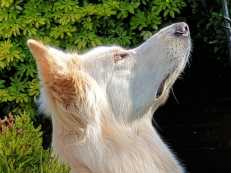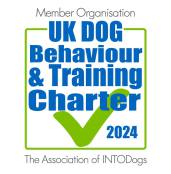The essential needs of your dog
Dogs, like humans, have basic needs for shelter, food and water, companionship, affection and a sense of belonging; to have the opportunity to exercise, play and to be free from pain.
Animal welfare standards exist for farmed animals in many countries in the world and there are, in some countries, similar requirements for companion animals. Although I feel sure not many people realise it, the Animal Welfare Act 2006 places a duty of care on dog owners in the UK to ensure they take reasonable steps in all circumstances to meet the Five Welfare Needs of their animals:
Environment - the need for a suitable environment
A dog should be provided with a suitable place to live, their own clean and dry bed in a quiet space which is free from draughts. He needs regular opportunities to toilet and a safe place to play, explore and exercise (the amount of the latter may vary depending on the age and health of the individual dog, but most dogs will need exercise every day). Dogs are inquisitive and will investigate their space and it is the responsibility of owners to keep their dog’s environment free from hazards and frightening ‘things’.
Diet - the need for a suitable diet
A dog should be provided with a well-balanced, nutritional diet together with constant access to water. The diet should be appropriate for the age, health and activity level of the dog and owners should monitor changes to weight and behaviour so amounts of food or the type of food given can be changed or tailored to the dog’s needs. Owners should also protect dogs from poisonous substances and toxic foods such as chocolate and raisins.
Behaviour - the need to express normal behaviour
A dog needs the opportunity to be properly socialised with other animals and everyday occurrences whilst a puppy in order to grow up to be a confident and well-behaved adult dog. They should be trained (using only positive, reward-based methods) to have good recall for their own safety off lead, toilet appropriately and to safely play with other dogs and humans. Good training enhances our relationship with a dog and their relationship with us. Where behavioural issues do exist owners should seek professional advice.
Companionship – the need to have appropriate company
Dogs are sociable animals and require the company of humans and usually other animals. However, if it is necessary for them to live apart from other animals perhaps because of previous aggression issues, owners should accommodate this need. As sociable animals, dogs should not be regularly left alone for more than 4 hours a day and preferably not every day. Without adequate companionship, dogs can become distressed, depressed, lonely, bored and destructive.
Health - the need to be protected from pain, suffering, injury and disease
Owners should check regularly for signs of injury and illness and seek veterinary advice as soon as it becomes necessary. Professional advice should also be sought regarding neutering, vaccinations, parasite treatments and dental care in order to maintain long-term health. Dogs also need to be regularly groomed and nails trimmed not just for cosmetic reasons but in order to maintain good skin health, posture and mobility. Owners are encouraged to take out pet insurance to cover unexpected veterinary fees and costs of medication as this can often be expensive and on-going for many years in the case of chronic conditions. Finally, in April 2016 it became a legal requirement for all dogs to be micro-chipped which will ensure, for example, ownership can be proved and making it easier for lost dogs to be quickly reunited with their owners preventing extended periods of distress.
June Pennell ISCP.Dip.Canine.Prac.
The Dominance Myth
The idea of a ‘dominant dog’ seems to have been hijacked by celebrity dog trainers and exponents of the now outdated ‘wolf pack’ dominance theory of dog behaviour. They believe that dogs want to dominate their human guardians to become the ‘alpha’ (dominant member in the relationship). They also believe that dogs are likely to become ‘pushy’ or aggressive towards their guardian if the guardian doesn’t show their own dominance over their dog.
We now know that this theory was based incorrectly on captive wolf groups, where behaviour between normally separate family groups forced to live alongside each other in captivity, caused tensions resulting in ‘unnatural’ behaviour not seen in the wild. In the wild, family groups remain separate, and resources are shared, but forcing groups together resulted in competition and squabbling not normally seen in the wild. Exponents of the dominance theory have incorrectly cited these ‘unnatural’ wolf behaviours as part of the domesticated dogs’ heritage. Sadly, they have been used to justify aggressive disciplining of dogs when exhibiting what they consider to be dominant behaviour. This type of discipline includes ‘alpha rolls’, where a dog is forcibly turned over on its back and pinned down by the throat, kicking, suspending from leads, hitting and punching.
Positive and force-free dog trainers understand that the observations of the captive wolf groups led to incorrect assumptions about domesticated dogs. Observations of dogs, in scientific studies, show dogs do not see humans as dogs and want to cooperate with us, not dominate us.
A dog’s natural instinct is for survival and dogs have evolved over the last 30,000 years to work with us to best ensure that survival. They depend upon us for not just their food but also for leadership, companionship, and safety. I believe when a dog exhibits fear-aggression it is because this contract has been broken in some way.
Guardianship should be about having a balanced relationship with your dog. There should be mutual trust, affection and an understanding that you will keep the dog safe from harm. I believe that you should always guide your dog to choose to do the right thing. When they don’t make the right choice, you should react calmly and redirect them without raising your voice and certainly without causing distress. I do, however, believe that you should also teach your dog that it cannot have everything it wants when it wants it and that cooperation leads to a comfortable life. I find it strange that this principle is understood by the majority when it comes to parenting children, but they do not see the connection with ‘parenting’ their dog.
Some dogs are definitely more confident and assertive than others; the result of nature, nurture or their own life experiences, or more usually a combination of all of these. Some dogs carry themselves with more confidence than others, when meeting strange dogs and humans. These dogs generally have an upright posture, appear more interested and alert, and are happy to return direct eye contact. Some dogs use their confidence, or over confidence perhaps, to show superiority (or dominance used in a correct way) over other dogs.
The difference between these two personality types is often interpreted as the first dog being more ‘dominant’ over the second but the mere use of this word conjures up the outdated ‘dominance over humans’ theory to many people and the association is proving hard to dislodge in peoples’ minds.
A positive trainer is more likely to interpret the difference between the two types of personality and calmly, and with kindness, explore what they might do to help make the first dog appear friendlier and the second dog more confident in the situation.
June Pennell ISCP.Dip.Canine.Prac.
Dogs and the Law
I believe all dog owners in the UK need to be aware that The Dangerous Dogs Act 1991 exists and that it has implications for all dog owners (and carers) not just those owning dogs of the banned ‘pit bull type’ breeds.
They need to know the law changed in 2014 to cover private property and to give greater protection to assistance dogs. Section 3 of the Act applies to every dog in England & Wales, and it makes no distinction as to whether the dog is pure bred, a cross breed, a mongrel or to its size. Since 2014 the Act says it is a criminal offence and action can be taken against the owner, or the person in charge of the dog if that is not the owner, when a dog is considered to be dangerously out of control. This now applies to both public places and private property including the owner’s or keeper’s home. A dog will be considered to be dangerously out of control if it injures someone or “on any occasion on which there are grounds for reasonable apprehension that it will injure any person or assistance dog.”
Section 1 relates to Breed Specific Legislation (BSL). In the UK this is defined by the Secretary of State as a “type appearing to him to be bred for fighting or to have the characteristics of a type bred for that purpose”. The banned breeds are Pit Bull Terriers, Japanese Tosa, Dogo Argentino, and Fila Braziliero. Under this law owners of registered dogs must ensure that the dog is neutered, micro-chipped, insured, kept in secure conditions and prevent it from escaping. The law also states that “it is illegal for anyone to breed, sell, exchange advertise or expose for sale, make or offer such a dog as a gift, allow such a dog in public without a lead and muzzle, abandon, or be in possession of a dog as named above.”
What most of us need to know is how to protect our dogs and the punishments for breaking the law. This is likely to be a destruction order for the dog and prosecution of the owner or carer with maximum penalties of 3 years prison for the injury or death of an assistance dog, 5 years prison for injury of a person and 14 years prison for the death of a person. There is also likely to be a fine and compensation to pay. If a child under 16 years old is left in charge of a dog, the head of the household will be deemed responsible. There was a ruling in 2013 that says if you can prove you left your dog in the charge of a fit and proper person you may have some defence.
Although not included in the Dangerous Dogs Act I would advise owners that they should be aware that in some public areas Dog Control Orders (now PSPOs) exist and there will be local council signs giving dog owners’ instructions. They should know that farmers still have the right to kill a dog if it is worrying livestock and from 6 April 2006 all dogs over the age of 8 weeks need to be micro-chipped.
I have a number of reservations about the UK Dangerous Dogs Act and the Breed Specific Legislation it contains. The laws are confusing which leads in particular to a lack of clarity over which breeds are actually banned and a misunderstanding that it doesn’t relate to you if you own, for example, a Labrador.
I worry about what constitutes private property; your home is and if an incident were to occur there may be a ‘householder case’ defence but this doesn’t extend to your garden, where if someone uninvited is injured by your dog, the dog may be presumed to be dangerous. There have been cases of dogs being euthanised in these circumstances and I find this unacceptable.
I also have major reservations about the phrase “grounds for reasonable apprehension that it will injure any person or assistance dog.” There are a great number of people generally apprehensive or afraid of dogs but we must rely upon a decision on what is considered ‘reasonable apprehension’. I asked several local police officers for their definition of reasonable apprehension and received a number of different answers. What is reasonable to one person may not be reasonable to another but I hope common sense would prevail.
In my opinion BSL is discriminatory and I have a compulsion to say that “the law is an ass!” The banned breeds are not recognised in the UK and this makes identification difficult. The law relies purely on whether a dog LOOKS LIKE a banned breed. Surely legislation should focus on deed and not breed! No breed is inherently dangerous.
BSL ignores scientific research that the pit bull terrier type dog is physiologically no different from any other breed and that they simply have strongly muscled jaws in common with many other breeds. It also ignores anti-social behaviour by people who raise and influence their dogs to be aggressive, irresponsible dog ownership and the continuing rise in dog bites from non banned breeds. There are no preventative measures included in the law.
The press recently reported on seized dogs, that are always denied bail and visits from family, and who are subsequently being kept for up to two years in a cage without being walked. This must not be allowed to continue.
Not directly related but I also believe that the press has demonised certain breeds. I seem to recall the German Shepherd being top of the list in the 1990s, the Rottweiler in the 2000s and currently it’s the turn of the Staffordshire Bull Terrier. I believe this just makes them more attractive to people who want to flout the law and use dogs as ‘status’ animals. Having adopted one of these it makes me furious that this is being encouraged.
June Pennell, ISCP.Dip.Canine.Prac.




